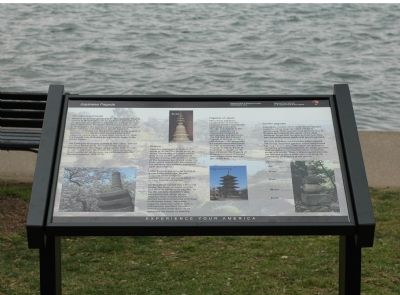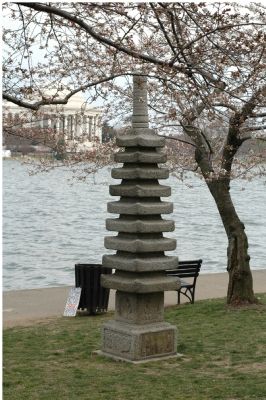The Tidal Basin in Southwest Washington in Washington, District of Columbia — The American Northeast (Mid-Atlantic)
Japanese Pagoda
National Mall & Memorial Parks
— National Park Service, U.S. Department of the Interior —
Admired by thousands each year, the Japanese Pagoda arrived in Washington, not as a gift from one nation to another, but as a gift from one man to another. In 1957, Ryozo Hiranuma, the Mayor of Yokohama and a visitor to Washington, DC four years prior, gave this pagoda to former District Commissioner Renah Camalier. However, Camalier felt the gift belonged to the people of the District of Columbia and placed it among the Japanese cherry trees. A year later, on April 21, 1958, the pagoda was dedicated as a gift from Japan to the United States.
The 3,800 pound pagoda arrived in five crates, without assembly instructions. Reconstruction required assistance from the Library of Congress staff. Though its age is unknown, the design and the four seated Buddhas carved on the base are consistent with the Kamakura period (1192–1333).
Origins. Pagodas originated in India as a stone or earthen burial tomb, or stupa, consisting of a dome with a pole in the center, which extends through the top. The bones or ashes of the deceased are placed under the pole, which represents the center of the universe and collects energy for birth and creation.
After Buddha asked to be buried in one 2,500 years ago, stupas acquired a new religious significance and generally stand in or near Buddhist temples.
As Buddhism spread into China and Korea, the stupa changed slightly and became known as a pagoda. In the 6th century, Buddhism was introduced into Japan where pagodas were usually several storied wooden structures with deep multi-tiered eaves. Japanese pagodas retain the central pole, or shinbashira, and have beautiful stones buried under the pole to represent Buddha.
Pagodas of Japan. The unique Japanese construction exhibits beauty and surprising endurance. Though susceptible to fire, Japan's pagodas are remarkably resistant to earthquakes and typhoons. The 104 foot tall, 5-tiered Pagoda of Horyuji in Nara, still stands 1,300 years after its construction and shows no sign of instability. The Pagoda of Toji, in Kyoto is the tallest in Japan, at 180 feet. However, the Pagoda of Shokokuji (before it burned down) was nearly twice as tall, at 355 feet.
Garden Pagodas. Essentially models of the multi-storied wooden pagodas, stone pagodas retain religious significance. They represent the philosophies of Buddha and console the spirits of the dead. Although found near temples and shrines, they also frequently grace public and private gardens.
The Zen Buddhist reverence for nature heavily influences Japanese gardens which tend toward balanced asymmetry, rather than the geometric symmetry of European gardens. In Japan, gardens look natural and incorporate
elements of water, stone, and plants. Thus, a stone pagoda provides the element of stone while also indicating the underlying philosophy of the garden.
Erected by National Park Service, U.S. Department of the Interior.
Topics. This historical marker is listed in this topic list: Horticulture & Forestry. A significant historical month for this entry is April 1972.
Location. Marker is missing. It was located near 38° 53.189′ N, 77° 2.499′ W. Marker was in Southwest Washington in Washington, District of Columbia. It was in The Tidal Basin. Marker was on Independence Avenue Southwest east of West Basin Drive Southwest, on the right when traveling east. Touch for map. Marker was in this post office area: Washington DC 20037, United States of America. Touch for directions.
Other nearby markers. At least 8 other markers are within walking distance of this location. The First Japanese Cherry Trees (a few steps from this marker); A Symbol of International Friendship (within shouting distance of this marker); Lighting the Way (within shouting distance of this marker); District of Columbia War Memorial (about 600 feet away, measured in a direct line); a different marker also named District of Columbia War Memorial (about 700 feet away); John Paul Jones Memorial (approx. 0.2 miles away); a different marker also named John Paul Jones Memorial (approx. 0.2 miles away); Washington Monument (approx. 0.2 miles away). Touch for a list and map of all markers in Southwest Washington.
More about this marker. This site’s editor has received word that this interpretive panel is only installed during the Cherry Blossom Festival (end of March, start of April). A permanent replacement marker is in the works and when it is erected this panel will be retired. —Nov 3, 2007.
Related marker. Click here for another marker that is related to this marker.
Credits. This page was last revised on January 30, 2023. It was originally submitted on April 28, 2006, by Tom Fuchs of Greenbelt, Maryland. This page has been viewed 9,567 times since then and 54 times this year. Photos: 1, 2. submitted on April 28, 2006, by Tom Fuchs of Greenbelt, Maryland. • J. J. Prats was the editor who published this page.

